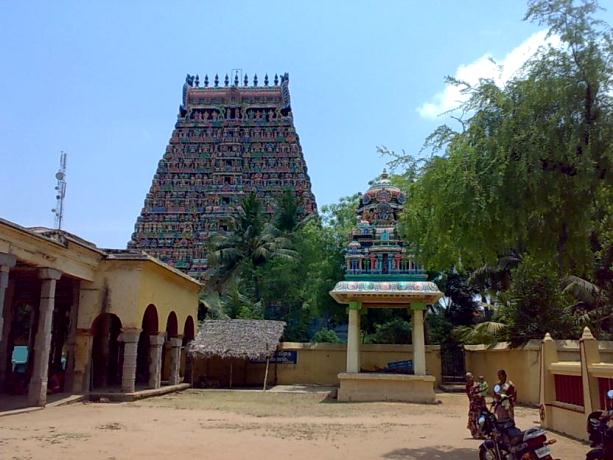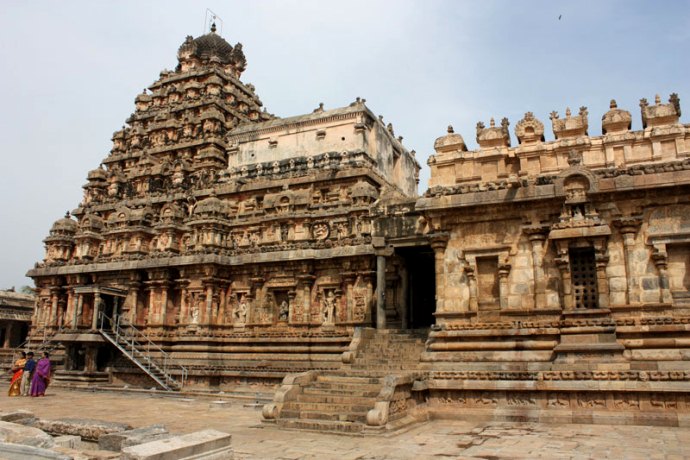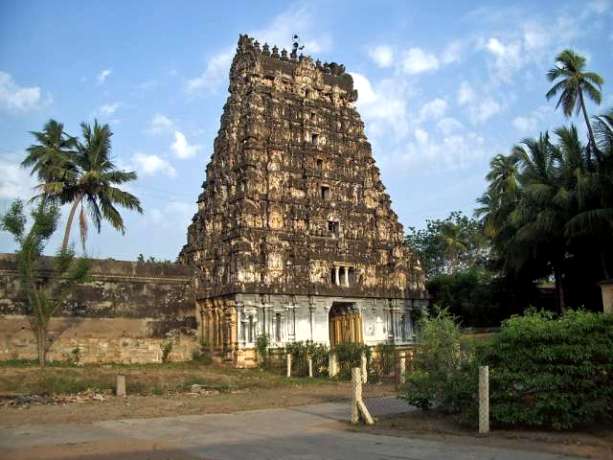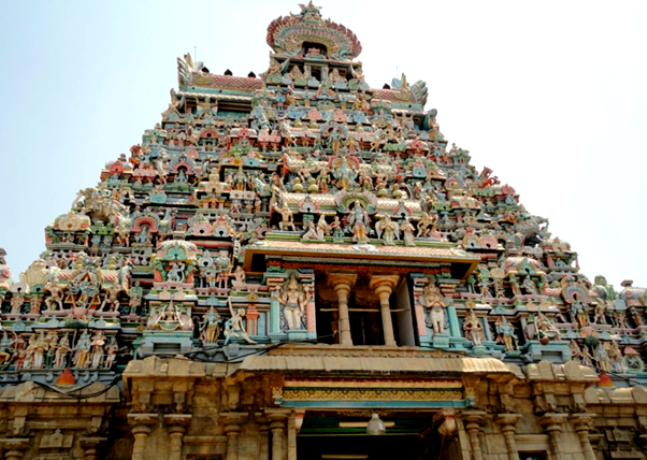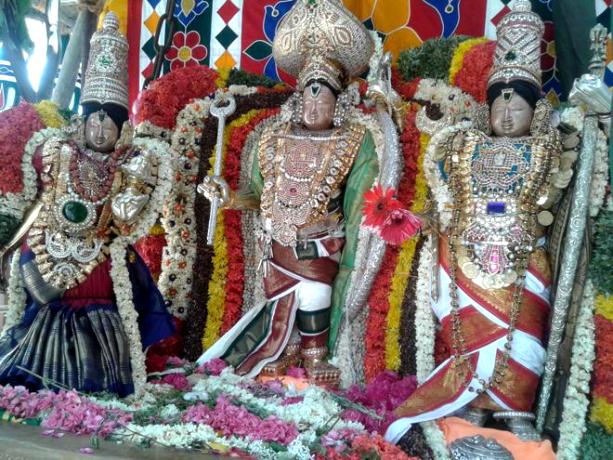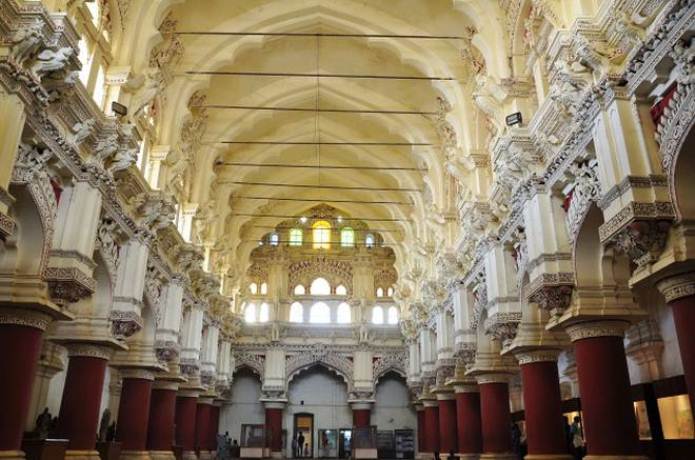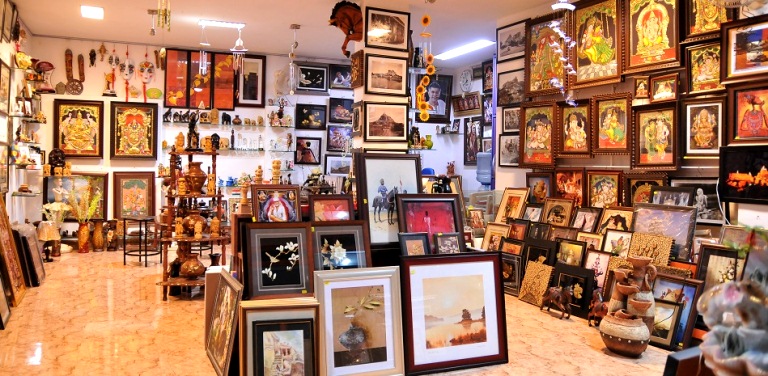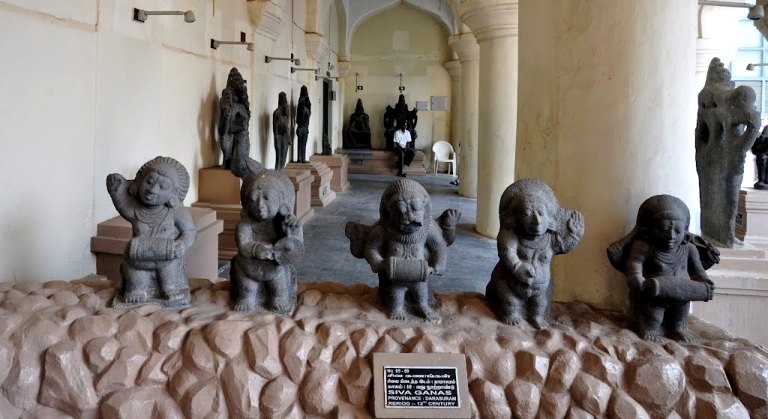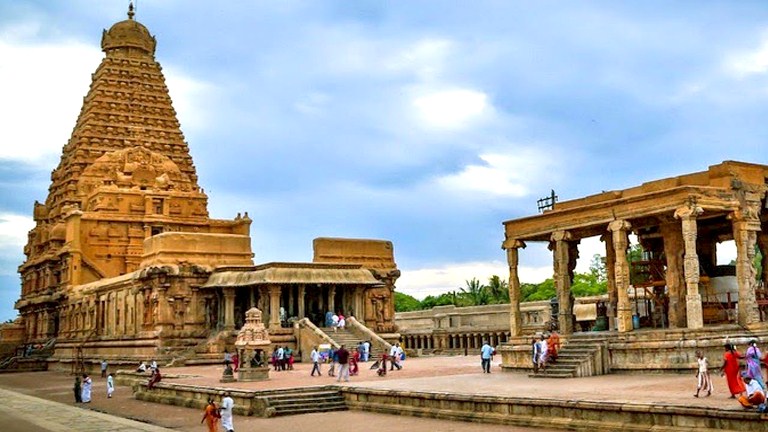
There are different criteria that lead to the christening of The Great Living Chola Temples. These temples epitomize the precision and beauty of Dravidian temples and are considered to have reflected outstanding creative achievement in the architectural front. Stone carvings and inscriptions of these temples are heavily acclaimed.
The Great Living Chola Temples have been listed as UNESCO World Heritage Site which includes three temples; The Brihadesvara Temple (Tanjavur), Brihadisvara Temple (Gangaikondacholisvaram) and Airavatesvara Temple (Darasuram).
The history of these temples dates back to 11th century CE. Chola Empire ruled over Southern India for quite a long time and built many temples during that span. Cholas were staunch followers of Lord Shiva and their temples reflect stability, prosperity and glory. Granite was mainly used by the Cholas for designs that consisted of kings, dancers, warriors and deities.
Brihadeeswarar Temple - Located in Thanjavur city of the Tamil Nadu state, Peruvudaiyar Kovil is one of the most popular temples in South India. Popularly known as Brihadeeswarar Temple, Rajarajeswaram and Raja Rajeshwara Temple, this popular Hindu temple is dedicated to Lord Shiva. Erected by Raja Raja Chola I, this temple is a wonderful example of Tamil architecture. One of the largest and greatest architectures in Indian history, it is also a UNESCO World Heritage Site as Great Living Chola Temple.
One of the country most prized possession, it stands safe amidst strong walls that were probably added in the 16th century. One of the temple tower, 66 m high, known as Vimana, is one of the world tallest towers. It is believed that the top part of the temple, called Kumbam, Chikharam or Kalasha, is made out of single stone carving.
Another single rock carving is the Nandi bull statue at the temple entrance. This sacred bull temples is 13 feet high and 6 feet long. The temple structure is made from granite. Commissioned by Raja Raja Chola I in 1010 AD, this temple is fondly called the Big Temple and turned 1000 years old in the year 2010.
Adi Kumbeswarar Temple Kumbakonam, Thanjavur- Dedicated to Lord Shiva, Adi Kumbeswarar Temple is a Hindu temple which is located in the town of Kumbakonam in Tamil Nadu. In the temple, Lord Shiva is worshiped as Adi Kumbeswarar. Covering an area of 30,181 sq ft (2,803.9 m2, the temple is visited by a number of devotees every year.
The temple has a lingam which is believed to be made by Lord Shiva himself. There is a Navratri Mandapa in the temple where one can find 27 stars and the 12 Zodiac signs carved on the stones. The temple houses a great collection of silver Vahanas (vehicles) which are used for carrying temple deities during festivals.
Adi Kumbeswarar temple has four gateway towers which are known as gopurams. The temple has many shrines other than Kumbeswarar and Mangalambigai Amman. One among the other shrines is the shrine of Jurahareswarar who is known to cure fever. Devotees from different parts of the world visit the temple to pray him to cure fever. There are many halls in the temple complex which were built back during the Vijayanagar period.
The Great Living Chola Temples- There are different criteria that lead to the christening of The Great Living Chola Temples. These temples epitomize the precision and beauty of Dravidian temples and are considered to have reflected outstanding creative achievement in the architectural front. Stone carvings and inscriptions of these temples are heavily acclaimed.
The Great Living Chola Temples have been listed as UNESCO World Heritage Site which includes three temples; The Brihadesvara Temple (Tanjavur), Brihadisvara Temple (Gangaikondacholisvaram) and Airavatesvara Temple (Darasuram).
The history of these temples dates back to 11th century CE. Chola Empire ruled over Southern India for quite a long time and built many temples during that span. Cholas were staunch followers of Lord Shiva and their temples reflect stability, prosperity and glory. Granite was mainly used by the Cholas for designs that consisted of kings, dancers, warriors and deities.
Ramaswamy Temple, Kumbakonam- Dedicated to Lord Rama, Ramaswamy Temple is placed in Kumbakonam, Tamil Nadu. The temple was constructed during the 16th century by Achutha Ramachandra Nayaka, one of Thanjavur rulers. The temple has idols of Lord Rama, his consort Goddess Seeta, Lord Rama brother Lakshmana, and Lord Anjaneyaa (Hanuman).Ramaswamy Temple is located right in the centre of the town and faces the north direction.
Like other South Indian temple, this temple is also known for its marvelous architecture. The main pavilion or Maha Mandapa consists of delicate stone carvings depicting different stages of Ramayana, the great Hindu epic. The outer area is festooned with wall paintings, 219 in number, explaining various important events of the same. The temple has 3-tiered gopurams. There are other temples also in this complex including Sreenivasa Sannathi, Alwar Sannathi and Gopalan Sannathi.
Naganathaswamy Temple, Tanjore- Dedicated to Lord Rahu (Raaghu Bhagvan), Naganathaswamy Temple is one of the Navagraha Temples. People from different parts of the country visit the temple to pay homage to Lord Rahu. Located at Thirunageswaram, which is 7km east of Kumbakonam in Thanjavur district, the temple is now declared as a protected monument by Tamil Nadu government.
The main deity presiding inside the temple is of Lord Naganathaswamy (Lord Shiva) and his wife Giri Gujambika (Goddess Parvathi). It is the only temple where Lord Rahu is worshipped in human face, while in other temples Lord Rahu is seen in serpent face. According to Hindu Mythology, Naganathaswamy is the place where Lord Rahu got relieved of his affliction, after worshipping to Lord Shiva.
Naganathaswamy is generally visited by people with Rahu dosha. Moreover, locals of the region claim that during milk abhisheka, the color of the milk turns from white to blue. The temple holds a big space and features four entry towers with fort like walls. The southern side of the temple has four Mandapas which are adorned with artistic pillars. Visitors have an option of visiting the Vinayaga temple, Balibeedam, Nandeeswarar Mandabam and Thwaja Sthambam which are located on the eastern gateway. Other attractions of the temple include bathing places namely, Suriya Pushkarani, Gowthama Theertham, Parasara Theertham, Indira Theertham and Prugu Theertham. It is believed that if one takes bath in any of these sacred places, all their past Karmas and suffering will disappear.
Lord Shiva is worshiped as Mahalingeswaraswamy in the temple. Lord Shiva is represented by the lingam and it is believed to be the focal point for the seven consorts of Shiva.
One can find around 149 inscriptions in the temple which indicate contributions from Pandyas, Cholas, Thanjavur Nayaks and Thanjavur Maratha kingdom. The structure of the temple is very large and it has four gateway towers which are known as gopurams.
Other than prominent shrines like Mahalingeswaraswamy, Pirguchuntaragujambigai and Mookambigai, there are many more shrines in the temple. Six daily rituals are performed in the temple where priests pay homage Lord Shiva.
Aiyarappar Temple Tanjore- Tanjore in Tamil Nadu is a wonderful place to visit. It holds a special place for art and history lovers. Even though its claim to fame is mainly the Brihadeeshwara Temple, there are other temples in Tanjore which are also quite impressive. Amongst the other temples of Tanjore which are well worth a visit is the Aiyarappan Temple.
There are a total of seven temples or Saptastanams dedicated to Lord Shiva. The Aiyarappan Temple, Tanjore is considered to be the most important one belonging to this group. Five tributaries of the River Cauvery coil their way around the town of Tanjavur and in the midst of the town the Aiyarappan Temple is located. The setting is indeed very tranquil.
The Aiyarappan Temple in Tanjore dates back to the ancient period but even after the passage of so many years it still stands tall. Lord Shiva is also popularly known as Panchanadhishwara or Aiyarappan in this part of the country and as this temple is dedicated to him, it has also been named after him.
The Aiyarappan Temple, Tanjore is not only large but beautiful as well. Songs in praise of the Aiyarappan Temple has been sung by several Shaivite saints and that points to its popularity. Many devotees come to offer their prayers and seek the blessings of the Lord in this temple. Visit the Aiyarappan Temple whenever you came to Thanjavur.
Airavatesvara Temple,Thanjavur- Built in 12th century A.D by Raja Chola II, Airavatesvara temple is a famous Hindu Temple located in Darasuram. The temple represents the architectural heritage of Tamil Nadu. Airavatesvara Temple is a World Heritage site declared by UNESCO. The temple is one among the Great Living Chola Temples.
Dedicated to Lord Shiva, the temple houses a linga named Airavatesvara. According to Hindu Mythology, Lord Indra elephant, Airavata was cursed by sage Durvasa for disrespecting him. As a consequence of Curse, the white elephant suffered skin discoloration which was curable only after taking a dip in holy water of Airavatesvara. This is how the temple and the presiding deity got a name from the incident.
Airavatesvara temple is architecturally beautiful and it has intricate paintings and sculptures on the walls. The temple is a storehouse of art and architecture which display the delicate stone carvings of ancient artists. The front Mandapa of the temple is designed in the form of a big chariot drawn by horses. Further, the vimaan on the top of the temple is 85ft. high. The temple is a must visit for history buffs and god lovers.
Thirunallar Temple,Tanjore- Placed between two rivers Arasalar and Vanchai, Thirunallar is a shrine of Hindu God, Shani. The temple attracts a new range of pilgrims every year. Located 3kms away from Karaika in Thanjavur, the Thirunallar temple comes under the Pondicherry Union Territory jurisdiction.
Thurunallar is the only temple where Lord Shani lost his powers to Lord Shiva in order to save his devotee. The devotee was the legendary king Nala, who got released from his sufferings after worshipping in this temple. The affliction was caused due to the evil influence of Saturn. People from different parts of the globe specially plan their visit to Thirunallar temple on Saturdays. (In Hindu mythology Saturdays are dedicated to Lord Shani).
Further, it is believed that if you take bath in the Theertams (bathing place), all the past karmas and the sufferings are cleared. Also, Theertam is one of the prime attractions of Thirunallar Temple. Therefore, Thirunallar temple is one of the best places in South India where you can offer sincere prayers.
Thanjavur Royal Palace Museum- Thanjavur is an important tourist destination that attracts thousands of tourists every year. The rich heritage can be seen in the huge collection of the antiques, images, paintings and art in the museum. The idols and the old sculptures from the age old temples like Brihadeshwara Temple and Gangaikondacholapuram Temple decorate the museum and allow the tourists to get an idea of the past.
Apart from the stone work, there are bronze sculptures. The metal sculptures of the Chola dynasty and Nayak dynasty, the idols of Hindu god and goddess give the tourists a feel of the religious background of the by gone days.
The ancient work of art, the glass paintings are the most attractive features of the museum. The sculpture of Bhikshatanamurti popularly known as Shiva in his different form as a beggar is an uncommon statue of Hindu God. The image of Shiva and Parvati at the time of their marriage can be seen in the museum. Apart from these main images there are sculptures, statues and paintings of other Hindu God and goddess.
The gallery of the sculptures only holds the statues from Pallava, Chola, Nayak and Pandya periods. There are house hold images that that depict the life of the common people of the age. They show the social picture of the age. The societies, the interiors of the houses of the age are displayed in this museum.
The wooden furniture and the intricate wooden work show the heritage and background of art and crafts of Thanjavur. The colorful paintings, the jewelry, costumes and reflect the lifestyle of the people of that age and are displayed for the visitors.
The Royal Palace museum, Thanjavur is centrally located and is accessible by the tourist with the help of any mode of transport.
Tanjore Art Gallery- Constructed in gorgeous Tanjore Royal palace of the Nayaks, Thanjavur or Tanjore Art Gallery is one of the prime attractions in Tamil Nadu. The art gallery is a storehouse of historic objects, paintings and sculptures of Hindu Gods and Goddesses. Built in 1600 A.D, the gallery has three different sections namely; Pooja Mahal, Indira Mandir and Rama Chowdam Hall. Visitors from all parts of the globe come to adore these intricate paintings and sculptures.
Displaying some of the variety of stone sculptures is the Pooja Mahal. Next is the Arsenal Tower or the Indira Mandir which display various forms of God and their weapons and the last is the Rama Chowdam Hall which has collections of images and idols of Bronze. Moreover, few of these art works were regained from Chola Dynasty (between 9th to 13th century), the Nayak Dynasty (17th to 18th century) and from Pallava era.
The huge art gallery also includes the Saraswati Library and the famous Sangeetha Mahal.
Siva Ganga Garden Thanjavur- Placed between Brihadeswarar Temple and Schwartz Church, Siva Ganga Garden is not only a very popular park but is also a famous tourist attraction in Thanjavur. Placed within the complex of Vijayanagar fort, it is quite close to the Thanjavur Palace. The park consists of a huge square tank, constructed in the 16th century that was the water resource for the palace. The garden was built by one of Nayaka rulers, Sevappa Nayaka. In the modern times, it is a popular picnic spot.
The park comprises of a playing area for children, the prime attraction. Tourists and locals can enjoy boat riding in the pond that is in the vicinity of the park. That is not all. There is small toy train and a theppakulam or a small temple, right in the center of the pond. If you are fond of reading, there is Thanjavur Municipal Library in the park complex.
This well-maintained lush garden is festooned with both non- flowering as well as flowering plants. Treat your eyes to the greenery spread all around and listen to the soothing chirping of the birds. Spot varied species of animals and birds at the miniature zoological park.
Sangeetha Mahal,Tanjore- India is renowned all round the world for ancient musical instruments and its well-learned artists. The southern part of the country has been the birthplace of several such well-famed personalities right from the ancient times. Located on the first floor of Tanjore Palace in Tamil Nadu, Sageetha Mahal is one of the best places for Sangeetha (music) lovers. Also, popular as the Hall of Music, the place was built in 1600 during the rule of Nayak King Sevappa Nayak.
Sangeetha Mahal is one of the prime highlights of Tamil Nadu, which attract people from all parts of the globe. The Hall of music is constructed in such a way to avoid echoing of sound waves. It maintains a perfect balance between absorption and deflection of sound. Furthermore, Sangeeetha Mahal exhibits some of the artifacts of ancient Tanjore, but in early times the place was used as a performance site where talented dancers and musicians used to showcase their talent. Here you can gain knowledge on some of the ancient artists and their unique talents.
Therefore, plan your visit to Sangeetha Mahal and get fascinated by the great musicians of past times.
Manora Fort Tanjore- Placed around 65 km from Thanjavur in the south Indian state of Tamil Nadu, Manora Fort is a magnificent fort which was erected by Serfoji II, the Maratha ruler in 1814-1815. Overlooking the Bay of Bengal, this eight-storied fort has towers in hexagonal shape that are 23 meters high. It is believed that there is a hidden underground walkway in the fort that is directly connected to Thanjavur main temple, Brihadeswarar Temple. General public can go only up till 2 floors because of the fear that the high towers might collapse, the other floors are closed.
Saraswati Mahal Library,Tanjore- Saraswathi Mahal Library is located in Thanjavur (Tanjore), Tamil Nadu. The library is one of the oldest libraries in Asia. The library has a rare collection of Palm leaf manuscripts and papers which were written long back in different languages including Tamil, Hindi, Telugu, Marathi, English and many more languages. The collection has around 60,000 volumes, out of which some volumes are on display.
The Library also has a collection of around 3076 Marathi manuscripts which date back to the 17th, 18th, and 19th centuries. Also, there are 22 Persian and Urdu manuscripts of the 19th century within the collection. One can also find medical records of Ayurveda scholars in the library.
The library started as a Royal Library for the Nayak Kings of Tanjore who ruled during 1535 - 1675 AD. In 1675, the Maratha rulers captured Thanjavur and they further developed the Royal Palace Library. After 1918, the Saraswathi Mahal Library became a possession of the state of Tamil Nadu. The name of the library has now been changed to The Thanjavur Maharaja Serfoji's Saraswati Mahal Library in order to pay homage to the last ruler of the Maratha Empire.
Need Aspark Help?
For Tour Packages, Vehicle Rental and Customer Care Support.
+91 9999 31 7846
booking@asparkholidays.comWhy Travel with Us?

Excellent Support
Our Team Available 24x7 for Customer support
Best Price & Savings
We Offer the Most Competitive Prices.
